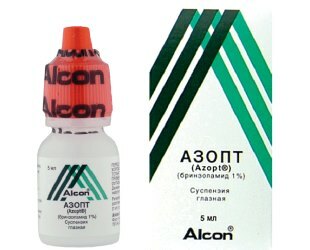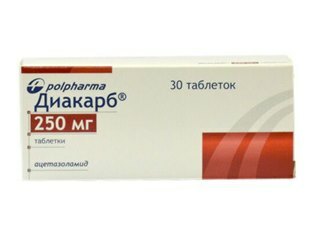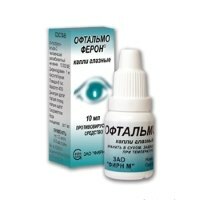
Glaucoma is still one of the main causes of disability and blindness of patients suffering from eye diseases.
This terrible disease often lurks people who turned 40-year-old barrier, and despite the use of trendy drugs, retains a tendency to serious complications in its background.
Azopt is a modern medicinal product related to antiglaucoma drugs. It is able to reduce intraocular pressure, which significantly helps in the fight against this ailment.
- 1. Indications
- 2. Composition, structure
- 3. Pharmacological action
- 4. Interaction with other drugs
- 5. Side effects
- 6. Specific guidance
- 7. Analogs
- 8. Conditionsshelf
- 9. Price
- 10. Reviews
- 11. CONCLUSIONS
action of the drug based on the effect of inhibiting carbonic anhydrase, whereby there is a reduction of intraocular fluid production and, as a result, decreased the intraocular pressure.
( At the end of the article reviews see patients after treatment "Azopt»)
Indications
eye drops or ophthalmic suspension Azopt effective at enhancing intraocular pressure( ocular hypertension) and glaucoma( open-form).
Method of application
The drug is instilled in 1 drop 2 times a day in the conjunctival sac of the eye.
Before use, the vial with droplets should be shaken several times, and after use, the bottle must be tightly closed with a lid.
According to the instructions, the maximum recommended taking precautions to avoid of infection when using the drops: the tip of the dispenser must not touch any objects or parts of the body during use( hands, skin of the eyelids, clothing, etc.)
release form, structure
Azopt madein the form of 1% drops or eye suspension for the eyes in 5 ml plastic bottles equipped with a dropper dispenser. In the cardboard box is the vial with the drug.
Eye drops( suspension) contain:
- main component of Brinzolamide 10 ml;
- auxiliary components: sodium chloride, sodium hydroxide or hydrochloric acid, mannitol, benzalkonium chloride, disodium edetate, carbomer( 974P), purified water. Pharmacological action
brinzolamide which inhibit( suppress) the impact of an enzyme called "carbonic anhydrase", located in the ciliary body of the eye, thereby effectively reduces the amount of production of excess intraocular fluid production. As a result, normalization of increased intraocular pressure occurs.
Using topically, Brinzolamide penetrates the bloodstream into red blood cells. This substance is excreted in urine along with other metabolic products.
Interaction with other
drugs It is not recommended to prescribe Asopt along with systemic inhibitors of carbonic anhydrase because of the possible enhancement of suppression reactions of this enzyme.
The combination of the use of Asopt with salicylates in high doses is fraught with violations in the ratio of acid-base balance and electrolyte balance, so it is not recommended.
Side effects of

The drug may adversely affect some organs or systems in the body, provoking such characteristic manifestations:
- From the viewpoint of possible such complications:
- dry eye mucosa, hyperemia, discharge, lacrimation, discomfort, itching, soreness;
- "blurring" of vision, sensation of the presence of a foreign body in the eye, a feeling of sticking together of the eyelids;
- inflammatory reactions in the form of conjunctivitis, keratitis, blepharitis, keratopathy, keratoconjunctivitis, astenopathy.
- rhinitis, pharyngitis, difficulty breathing.
- specific taste in the mouth( including bitter, sour, salty);
- feeling of dry mouth, nausea, digestive disorders, stool disorders.
- increased pressure, chest pain after very little physical exertion;
- pain in the kidney area.
- dermatitis, allergic reactions, urticaria.
- dizziness, headache.
Contraindications
To the absolute contraindication is the increased sensitivity of a person to the constituent components of these drops.
However, there are a number of diseases that require special care in the use of this drug.
With caution Azopt should be used when:
- severe functional liver disorders( including hepatonecrosis);
- expressed disorders in kidney function( QA & lt; 30 mL / min);
- severe allergic reactions( Stevens-Johnson syndrome, etc.);
- disorders from the blood( aplastic anemia, agranulocytosis);
In all cases of severe adverse reactions, the use of this drug should be discontinued immediately.
Special instructions
The benzalkonium chloride, which is part of this product, is able to accumulate in excess quantity in contact lenses, therefore they are worn no earlier than 15-20 minutes after using the drug.
If any drops are used in addition to Azopt, then they can be instilled not earlier than 15 minutes after using this substance.
Caution should be applied to the droplet data when driving vehicles or controlling other mechanisms. There have been cases of blurred vision or blurred vision after application of the drug. Also, do not immediately after applying the medicine to perform tasks that require good vision and quick response.
Use in Pediatrics
No information is available on the safety and efficacy of Azopt in pediatric practice due to the lack of research conducted in children.
Pregnancy and lactation
No studies have been conducted on the efficacy of Azopt in pregnant women. As a consequence, it is not recommended to use the drug for pregnant women. The potential risk to the fetus of the constituent parts of the drug should be considered.
There is also no data on the content of this drug in breast milk. Therefore, if a given woman is prescribed a breastfeeding woman, breastfeeding of the baby should be stopped.
Analogs

There are no analogues of this preparation containing the same active substance. In case of intolerance of this drug, it is possible for a doctor to replace it with another similar preparation.
Similar and unit-specific drugs are Diuremide, Diacarb, Brinzolamide.
Storage conditions and storage times
Store the drug in a place inaccessible to children with a temperature range of 4 to 30 degrees Celsius. The place should be protected from the sun.
With strict observance of all storage conditions, the manufacturer guarantees the product's shelf life for 2 years.
After opening the vial, the drug is used for no more than 4 weeks to maintain efficacy and lack of infection.
Price
The average price of the drug in different cities and pharmacy chains in Russia ranges from 622 rubles to 806 rubles per bottle.
The average price of the drug in cities and pharmacies in Ukraine is also subject to significant fluctuations, ranging from 169 hryvnia to 554 hryvnia per bottle.
Reviews

Igor Sergeevich, Moscow region
"These drops have been assigned to my old mother. She has an extremely high intraocular pressure, and the diagnosis sounds like "corner-glaucoma".Read the instructions, and horrified by the mass of side effects. But we did not see any other way out, and my mother began to use these drops. It would be desirable to tell or say, that pressure this preparation reduces perfectly, at once eyes cease to hurt or be ill; be sick.
But the reverse side of the coin is that after taking the drops there is a side effect on the whole body. Previously, my mother did not complain about pancreatic, nausea, bitterness in her mouth. .. Is this too much for some drops?
Plus, it's still outrageous that the medicine is not cheap, and after opening the bottle they can be stored for only 4 weeks. We will look for an alternative to these drops. "
Yakovenko Stepan, Kirovograd
"I was prescribed Asopt with a high eye pressure. Before that, my vision was completely blurred, as in old Soviet TVs. A week later, as this medicine began to drip, vision began to improve. Now my doctor thinks that I should be appointed further, because you will not spend all your life on one drop. "
Sinelnikova Snezhana, S.Peterburg
"I was given glaucoma, and I was shocked. But the doctor calmed me down, said that my form of glaucoma( open-angle) is normally treated. To me have written out Asopt in drops. After its application, vision became better, but there was some kind of dryness, not only in the eyes, but in the mouth. While the drop does not cancel, I will tolerate, because vision is a serious thing. "
Rustam Kalmykov, Chernigov
"I accidentally found out that I have glaucoma. I passed a medical examination in the sports dispensary, and my eye pressure was increased. The doctor appointed me Pilocarpine, but he got used to it, and I was prescribed Azopt.
From him, I quickly recovered my sight. The ophthalmologist promises a full recovery, and I believe him. Thanks to Azoptu, I will soon be back in sport again. "

Read on - instructions for use on Ophthalmoferon. How correctly to take a remedy?
In the article( tyts) Moscow center of vision restoration.
Prices for tablets Actovegin.http: //moezrenie.com/lechenie/ glaznye-mazi / aktovegin-dlya-zazhivleniya-ran.html
CONCLUSIONS
- Asopt is a modern drug related to antiglaucoma drugs. It effectively and long-term reduces intraocular pressure, helping in the fight against this ailment.
- Asopt is indicated for use in such ophthalmic diseases: open-angle glaucoma, ocular hypertension.
- The medicine is instilled in 1 drop 2 times a day in a conjunctival sac of one or both eyes, depending on the lesion.
- Caution should be used with the drug along with carbonic anhydrase inhibitors and salicylates because of possible negative effects on the body.
- The drug is contraindicated for hypersensitivity to its components, as well as for severe liver and kidney dysfunctions.
- Azopt may in some cases provoke various side effects on various organs and systems. In severe cases, the drug has to be canceled.
- When using Azopt with other drops for the eyes, it is necessary to take a break between their use for 15-20 minutes.
- Asopt is not used in pregnancy, lactation and in children's practice.
- Does not show the use of the drug before driving vehicles or work, requiring increased attention and accurate reaction.
- There are no complete analogues of this drug. The most approximate in action are the preparations Diuremides, Diacarb, Brinzolamide.
- The drug is stored in a dark dry place at a temperature of 4-30 degrees in a place protected from penetration of bright sunlight.
- The majority of patients positively assess the effectiveness of the drug in the treatment of glaucoma. Among the shortcomings are the presence of many side effects, the high cost of medication and the short shelf life of the bottle after the drug is opened.
